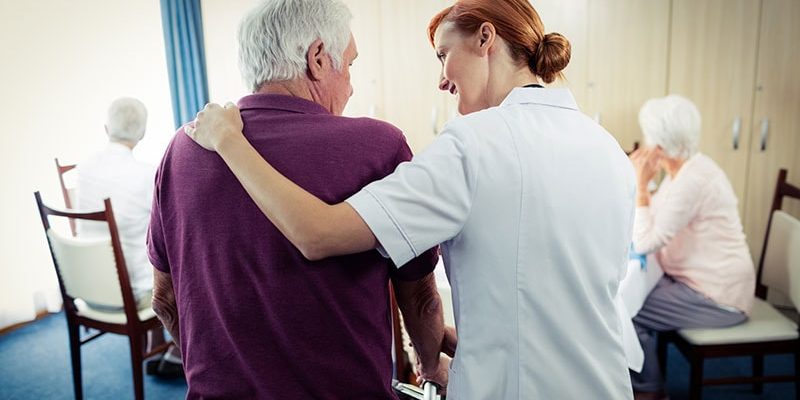It’s a mystery wrapped in research findings hidden inside a pandemic.
More than 3 years into it now, COVID-19 continues to surprise us. This time, researchers found people in long-term care facilities with the BA.1 or BA.2 variant in 2022 were more likely to get COVID-19 during the later BA.5 wave, compared with others who never tested positive for COVID-19.
This finding was unexpected. It contradicts a widespread belief that one infection always provides robust protection against the next. The result also highlights a need for everyone — but especially older adults in nursing homes and long-term care facilities — to stay up to date on COVID-19 vaccinations, investigators said.
The reason for the reinfections remains a bit of a mystery. Senior author Dawn M.E. Bowdish, PhD, and colleagues don’t know why the previously infected were at least 30 times more likely to get COVID-19 compared with the uninfected from the same group-living settings.
“One of the things we found is that the people who had these repeated infections didn’t seem to mount much of an immune response to the first infection — but that can’t explain the entirety of their risk,” said Bowdish, Canada research chair in aging and immunity at the McMaster Immunology Research Centre in Hamilton, Ontario, Canada.
So, it’s not just lower antibody numbers — something else is going on. “Probably there are many immunization properties associated with these viruses that we just don’t understand,” Bowdish said.
Consider the Context
The likely explanation goes beyond one Omicron variant making people more susceptible to another, said Eric J. Topol, MD, professor of molecular medicine and executive vice president of Scripps Research, and founder and director of its Scripps Research Translational Institute, in La Jolla, California. Topol is also editor-in-chief of Medscape, WebMD’s sister site for healthcare professionals. “There’s over interpretation to say that the infections [alone] made for higher risk.”
Instead, “it is more about the people — for whatever reason, the environment they’re in or the virus itself,” Topol said. He explained that by the time the Omicron variants arose, the virus had already evolved so much that the immune system response was less robust. This may have left some people more vulnerable to additional infections. It could also be that nursing home protections were insufficient, despite the best efforts of staff, as highlighted in The New York Times this week.
A Fully Vaccinated Population
The researchers included 318 randomly selected people from 750 residents across a range of different long-term care facilities in Canada. The study was published online August 21 in the journal eClinical Medicine.
All participants completed four monovalent vaccinations. Almost 18% developed COVID-19 during a follow-up period.
The median age was 87 years. It is well accepted that an aging immune system is slower and less powerful than a younger one. But the implications of the study go beyond the natural decrease in immunity with age known as immunosenescence.
The effects of aging on immunity vary so much between people that a 50-something person could have the same immune strength as someone in their 70s. Bowdish said, “The immune system is continually shaped by all your exposures and all your experiences — so some immune systems age much faster than others.”
It’s also not that those reinfected had weaker overall immune systems regardless of COVID-19 status. The researchers were able to rule that out.
Their findings line up with previous studies that show a wide difference in people’s ability to produce antibodies from a previous infection, called humoral immunity. For this reason, Bowdish is a proponent of boosting “cellular immunity” or the protection people can get from immunization.
“I am wholeheartedly in support of vaccinations,” she said.
On a positive note, the increased risk for reinfection in the study appears temporary. “We’ve followed these people now past the BA.5 infection and it’s not that they’re permanently susceptible to more infections.”
‘Challenging’ to Do Now
The researchers assessed residents of nursing homes and other long-term care facilities because of a large amount of COVID-19 testing. These organizations reported surveillance testing, asymptomatic testing, contact testing and symptomatic testing in 2022, for example.
“Most places in the world have moved away from collecting really good data and relying on things like wastewater testing and hospitalizations, and you would never find this sort of association that way,” she added.
Even if the current situation is less clear, the data is “incontrovertible that older adults need frequent vaccination,” Bowdish said. Frequent immunizations could help minimize the waning of vaccine effectiveness over time. Most people in the study who developed a reinfection did so within 6 months of their first infection, for example.
Bowdish said, “We need to get everyone up to date with their vaccines before the predicted fall wave.”
Damian McNamara is a staff journalist based in Miami, Florida. He covers a wide range of medical specialties, including infectious diseases, gastroenterology, and critical care. Follow Damian on Twitter: @MedReporter.
For more news, follow Medscape on Facebook, Twitter, Instagram, and YouTube.
Source: Read Full Article
